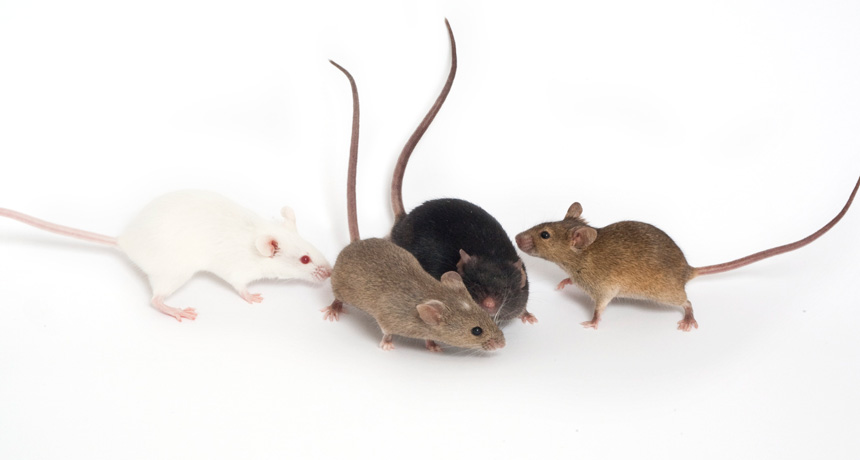Genes influence Ebola’s impact
Mice bred for diversity reveal how virus effects can differ among individuals

SIMILAR BUT DIFFERENT Mice that are genetically diverse respond to an Ebola infection with a spectrum of different symptoms, suggesting that genetics may play a role in how an individual responds to the virus.
Jennifer L. Torrance/Jackson Laboratory
Surviving or succumbing to Ebola may depend on a person’s genes.
After infection with the deadly virus, an individual’s genetic makeup could determine how hard Ebola hits — and whether it triggers the disease’s brutal bleeding, a study in laboratory mice suggests.
The group of mice used in the study is the first to mimic the spectrum of symptoms seen in humans and may offer scientists a better way to figure out how the virus ticks, researchers report October 30 in Science.
“This is a really exciting tool that people can use to study Ebola and potentially develop drugs or vaccines,” says study coauthor Angela Rasmussen, a virologist at the University of Washington in Seattle.
Although Ebola is famous for its grisly symptoms, humans’ responses to the virus vary. “A lot of people think that when you get Ebola, there’s only one outcome: This sort of extreme, ‘Hot Zone’ thing where you’re bleeding everywhere and vomiting blood,” Rasmussen says. But these hemorrhagic symptoms affect only 30 to 50 percent of Ebola patients.
Scientists had suspected that genetic factors might tweak an individual’s response to Ebola infection, but no one knew for sure. What’s more, other factors, such as whether a person had previously encountered the virus, could also affect disease outcomes, says geneticist David Threadgill of Texas A&M University in College Station. “Until this mouse study, there was no way to know why we had variation in the human population,” he says.
Scientists often study laboratory mice to glean information about how diseases wend their way through the body. But typical lab mice don’t react to Ebola the same way that humans do. Though the disease can be lethal, it doesn’t wallop mice with the hemorrhagic bleeding and fever seen in humans.
Without mice that match human responses to Ebola, scientists can’t be sure whether what they observe in animals applies to people too. So Rasmussen and colleagues zeroed in on a relatively new group of lab mice, one that’s more genetically varied than typical lab strains.
This group, a collection of varied mouse strains called the Collaborative Cross, comes from breeding together eight different strains of wild and lab mice. In a typical laboratory strain, any two animals would be like identical twins, says Gary Churchill , a geneticist at the Jackson Laboratory in Bar Harbor, Maine, who helped create the new group of mice years ago. “At their most extreme,” he says, “any two Collaborative Cross mice are as different from each other as the most different humans on Earth. Maybe more so.”
Examining the mouse equivalents of Shaquille O’Neal and Mary Lou Retton gives scientists a better picture of how diseases may affect diverse populations.
Working in one of the NIH’s most secure biosafety labs, decked out in full protective gear — “It’s the space suit lab,” Rasmussen says — she, University of Washington virologist Michael Katze and colleagues injected a mouse version of Ebola into 47 different strains of Collaborative Cross mice. Within days the team saw a range of symptoms similar to those found in humans.
By comparing mice resistant to Ebola to those susceptible to developing the hemorrhagic fever, the researchers discovered that a gene in charge of blood vessel leakiness might play a part in the disease. Because the mice differed only in their genetic makeups — not in the amount or type of virus researchers infected them with — Rasmussen and colleagues conclude that an animal’s genes help dictates its response to Ebola.
And since “the mice’s disease symptoms are so similar to what we see in human patients,” she adds, “we can say that this is most likely true in humans as well.”






